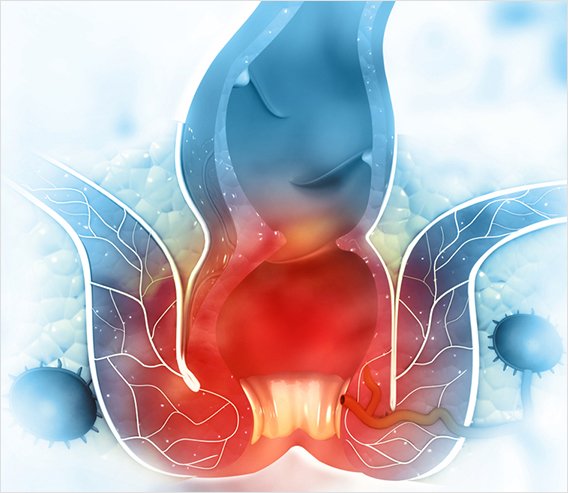Hemorrhoids Specialist
Hemorrhoid treatment focuses on relieving the patient’s symptoms. This may include lifestyle changes, the use of topical creams, and endoscopic or surgical correction when needed. The team at the Association of South Bay Surgeons are experienced, treats hemorrhoids on an outpatient basis.
Hemorrhoids Q & A
Hemorrhoids are very common today, with around 50% of people having them by the time they turn 50. While hemorrhoids are seen in both sexes, they are especially common among women because they often develop during pregnancy. However, hemorrhoids during pregnancy are usually temporary and resolve after the baby is born.
If a patient experiences rectal bleeding or bloody stools, they’re usually evaluated for hemorrhoids and digestive diseases, such as colorectal cancer. The physician does a visual examination of the anus and rectum to search for enlarged blood vessels indicating hemorrhoids. Additionally, the doctor does a digital exam of the rectum using a gloved and lubricated finger. This allows the doctor to feel abnormal swelling or growths. To make a hemorrhoids diagnosis, particularly in the case of internal hemorrhoids, an anoscope may be used to light up the interior of the rectum so it can be viewed more closely. In some cases, a proctoscope exam, which allows for a full exam of the whole rectum, is used to make the diagnosis.
Internal hemorrhoids can be treated in several different ways. Infrared coagulation (IRC) is the leading outpatient treatment for hemorrhoids. This non-surgical treatment uses infrared light exposure to coagulate the blood vessels that feed the hemorrhoid. Over the next few weeks, the hemorrhoidal tissues gradually shrink and recede. In a rubber band ligation, a rubber band cuts the blood supply to the hemorrhoid internally, which makes it wither. In sclerotherapy, a special chemical solution is injected directly into the blood vessels to force the hemorrhoid to shrink. In cases where none of these solutions are effective, especially when the patient has severe hemorrhoids, a surgical procedure called hemorrhoidectomy is performed.
Patients can do several things to help prevent hemorrhoids. Keeping stools soft is important, as it means less pressure and straining. This can be accomplished through eating plenty of fiber and using a fiber supplement. The doctor may also recommend a bulk stool softener. The bowels should always be emptied as quickly as possible when the urge occurs, but patients should be mindful of heavy straining.
Sitz Baths
A soothing, cleansing and healing soak or immersion of your perianal/pelvic/rectal area in clean warm water. Additives or salts are not recommended. You may use your own bathtub or you may purchase a special basin for the toilet called a “Sitz Bath”.
You can do a Sitz bath 3 times a day for 10 minutes each time.
If you purchase a Sitz Bath basin:
- Please follow the instructions that come with the product to ensure proper use.
- Remove dressings or bandages, if any, from the area that you will be soaking.
- Use comfortably warm water to fill Sitz bath and follow instructions that come with product.
- When you are finished, pat the area dry and replace any dressings or bandages that you were ordered by your physician, if applicable.
- Make sure there is a non-skid surface in the bottom of the tub.
- Make sure your bathtub is clean and washed before and after every use.
- Remove dressings or bandages, if any, before getting into the tub.
- Fill the bathtub halfway full with comfortably warm water.
- Sit in the tub with your knees bent. Add warm water as needed.
- When you are finished, pat the area dry and replace any dressings as ordered by your physician, if applicable.
Patients can do several things to help prevent hemorrhoids. Keeping stools soft is important, as it means less pressure and straining. This can be accomplished through eating plenty of fiber and using a fiber supplement. The doctor may also recommend a bulk stool softener. The bowels should always be emptied as quickly as possible when the urge occurs, but patients should be mindful of heavy straining.
Things to know:
- Do not use a bathtub to do your sitz bath if you are feeling weak or dizzy, or if you have difficulty getting in and out of a low seated position.
- Make sure the water is not too hot. Test a small area on your wrist under your palm, if that feels uncomfortable or too hot, allow water to cool until you are able to tolerate.
- If you do not have access to a bathtub or a basin, you may also use a detachable showerhead and run the water over your perianal area. Without a detachable showerhead, this may be accomplished by letting water run down your backside in the shower, in a slightly bent over position.
High Fiber Diet
A high fiber diet provides bulk in the stool and helps keep bowels regular. This diet can be used in relieving symptoms and aid in the prevention and treatment of diverticular disease, hemorrhoids, constipation, colon and rectal cancer, Crohn’s disease, Ulcerative Colitis, irritable bowel syndrome, anal fissures, hypercholesterolemia, and obesity.
The recommended daily amount of fiber is 25 to 35 grams per day. Most Americans consume much less than the recommended amount.
Important Points:
- Foods with the most fiber are whole-grain breads and cereals, grains, fruits, and vegetables.
- Scan food labels for bread and cereal products listing whole grain or whole wheat as the first ingredient.
- Chopping, peeling, cooking, pureeing, and processing may reduce fiber content.
- Add more fiber to your diet gradually. If fiber is added too quickly, it may cause gas, cramping, bloating, or diarrhea.
- Drink plenty of fluids while on a high fiber diet: At least 64 ounces (8 glasses) every day.
Examples:
Breads, Cereals, Rice, Pasta
- Whole-grain/wheat breads, muffins, bagels, or pita bread
- Rye bread
- Whole-grain/wheat crackers
- Whole-grain/wheat or bran cereals
- Oatmeal, oat bran, or grits
- Whole-wheat pasta
- Brown Rice
- Barley
- Quinoa
- Wheat germ
Beans, Legumes, Nuts, Seeds
- All beans and legumes such as: baked, beans black beans, black-eyed peas, garbanzo beans, kidney beans, lentils, lima beans, split peas, pinto beans
- All nuts such as: almonds, Brazil nuts, cashews, peanuts, peanut butter, pecans, pistachios, walnuts
- All seeds such as: sesame seeds, sunflower seeds
Vegetables
- All vegetables such as: artichokes, asparagus, broccoli, Brussel sprouts, cabbage, carrots, dark leafy greens, green beans, mushrooms, onions, peas, peppers, potatoes with skin, snow peas, spinach, squash, sweet potatoes, tomatoes
Fruit
- All fruit such as: apples, avocado, bananas, berries, grapefruit, kiwi, mangoes, nectarines, oranges, peaches, pears, plums
- Dried fruit (apricots, dates, raisins, prunes, etc.)
You may need to add fiber to your diet with a powder supplement such as Citrucel, Metamucil, or Benefiber.
One spoonful in a glass of water (or juice or gatorade, etc) 1-3 times daily.
You may also try fiber pills or gummy pills that are also available over the counter.



Leave a Reply